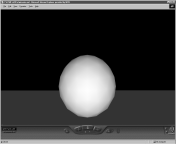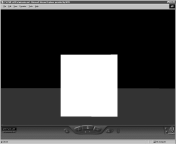Sound-Induced Mental Imagery for the Blind

« The vOICe Home Page
Visual imagery may be loosely defined as visual mental processing that resembles
the perceptual mental processing normally induced by the eyes, but now occurring in the
absence of direct sensory stimuli from the eyes. This visual mental
processing may be characterized by certain (conscious, subjective) experiences, but
also by vision-related cognitive processes and representations in the brain that are
not, or not directly, accessible to consciousness.
Visual imagery encompasses (the visual aspects of) dreaming, visual memory, (cognitive)
imagination, and any visual mental (re)constructions involved in the latest
information-rich synthetic vision technology for
the blind.
In the literature, the term mental imagery is often used almost as an
alias for visual imagery (visualization, or "seeing in the mind's eye")
due to the attention given to vision, although strictly speaking one should
reserve the mental imagery term for more general use,
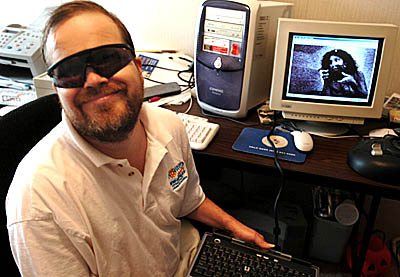
The vOICe for synthetic mental imagery: "seeing with your ears".
Adam Shaible, 37, gets visions through glasses with a camera and
headphones hooked to a laptop computer. The image on the monitor
is that of photographer Susan Stocker as she takes his photo.
Photography: Susan Stocker for Sun-Sentinel
("Device
lets man, blind since birth, hear the sights of sunset", April 26, 2004)
|
|
including, e.g., auditory imagination, imagining sounds. On the other hand,
with synthetic vision for the blind, the internal mental representations may be,
but need not be, truly visual in terms of quasi-pictorial or "screen-like" internal
representations, so to leave this issue open it may be better to speak of
mental imagery rather than just visual imagery here.
Therefore, we will mainly use the mental imagery term from now on, although we
use and apply it only in the context of vision and vision substitution.
Note that with sensory substitution for the blind, the mental processing and experiences
will in fact be much less subjective than with most of the other forms of mental imagery,
because it is again bound rather directly and tightly to sensory input, although not
from the eyes like with natural vision, but from a substituting auditory display or a
tactile (haptic) display. The imagery content is set mainly by the alternative sensory
input and less directly by conscious control - although one can of course focus
attention to parts of the perception or of any corresponding short term sensory
memory (sensory buffer) as well as control where the alternate input device is
being "pointed at".
The topic and concept of mental imagery has been much discussed and debated in
the literature, but so far mainly in a philosophical and psychological setting.
This makes that although some publications do address the meaning of mental
imagery to, for instance, the congenitally blind (e.g., John Kennedy), surprisingly
little has been published about the relevant mental imagery questions as now posed
by new technology options for substituting one sensory stream by another. This is
most unfortunate, because state-of-the-art synthetic vision technology,
based on camera or sonar sensor input and auditory or tactile display output,
poses very concrete and socially relevant questions about (the limitations of)
mental imagery, and the alternate sensory induction thereof (synthetic imagery),
questions that should be leading to significant follow-up in psychological theory,
prediction and experiment. See also the SIGGRAPH 98,
VSPA 2001, NIC2001 and
Tucson 2002 presentations on this topic. Moreover,
technologies for sensory substitution allow for testing philosophical ideas and
hypotheses about the essence of vision, for instance to help establish to what
extent sensorimotor contingencies (sensory invariants) can suffice for evoking
visual sensations and visual experiences (Cf.
 Alva Noë,
``Is the visual world a grand illusion?'' and related work by Kevin O'Regan,
and the claim of sensorimotor dependency theory as formulated by Andy Clark in
Alva Noë,
``Is the visual world a grand illusion?'' and related work by Kevin O'Regan,
and the claim of sensorimotor dependency theory as formulated by Andy Clark in
 ``Cognitive complexity and the sensorimotor frontier,''
reading "towhatever extent it is possible to recreate the same
body of sensorimotor dependencies using an alternative route, you
will recreate the full content and character of the original perceptual
experience", Aristotelian Society Supplementary Vol. 80, No. 1, pp. 43–65, 2006).
``Cognitive complexity and the sensorimotor frontier,''
reading "towhatever extent it is possible to recreate the same
body of sensorimotor dependencies using an alternative route, you
will recreate the full content and character of the original perceptual
experience", Aristotelian Society Supplementary Vol. 80, No. 1, pp. 43–65, 2006).
Historically, part of the debate on mental imagery has circled around the
behaviorist criticism on the non-provable existence of subjective experiences
(e.g., Watson). With modern brain-scanning techniques like PET and fMRI,
which show increasingly reliable correlates between the subjective and the
objective, this fundamental scientific criticism starts to lose ground.
Another source of much debate has been the concept of quasi-pictorial
or "screen-like" visual imagery as a (conscious) experience (Stephen Kosslyn),
"versus" or supplemented by the underlying (partly non-conscious) visual
processing and representation needed to do the coding or decoding (Zenon Pylyshyn).
It seems likely that neuroscience will help disentangle some of these issues in
the forthcoming years, and help clarify which ideas and categories turn out to be
mainly conceptual artefacts of our culture and philosophy, and which ideas can be
demonstrated to have a locatable neural substrate. For instance, the relations
and distinctions between short term visual memory (iconic memory) and spatial
processing with its working memory (as used in navigation) are currently subject
to intensive neuroscientific research.
| Live Sound-Induced Visual Imagery |
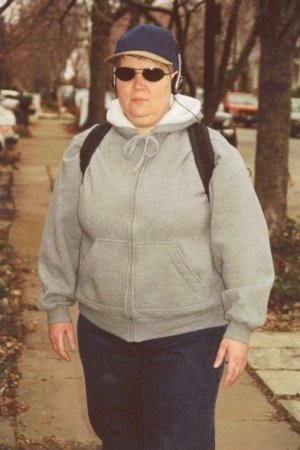
|
This blind user wears The vOICe daily, here with a hidden "spy camera" inside the hat: a "hatcam".
The notebook PC is inside the backpack.
|
|
Photography: courtesy Barbara Schweizer
|
|
The vOICe vision substitution and synthetic vision technology, as presented on this website,
is about a new mental imagery approach via live sound-induced and sound-controlled
visualisation or "perceptualization", for which first real-time hardware
was developed, later followed by a multimodal online Java applet
demonstrator as well as fully integrated video sonification software for blind users
in the form of The vOICe for Windows.
Having been developed as an experimental system for auditory image representations, it
is intended to find applications as a synthetic vision device for the blind. As such,
it is sufficiently general to support situated vision, suited for the dual purposes of
object recognition and the control of action (Pylyshyn). Presently, The vOICe offers a
first order approach consistent with basic psychophysical knowledge about the human
hearing system, while containing a sufficiently large set of parameters to allow for much
of the subsequent second order fine-tuning for improved perceptual performance
as more knowledge about human auditory processing and perception becomes
available. See also the auditory model page. The big question
in the context of mental imagery is to what extent The vOICe approach can indeed be
used to replace regular vision via sound-induced mental imagery, or "scaffolded" mental
imagery, making for a kind of artificial synesthesia (which
can be viewed as a special form of acquired synesthesia). One could also ask the question
if using The vOICe could help in preventing, guiding or treating Charles Bonnet syndrome (CBS),
which is about visual hallucinations that occur in people who go blind, most likely due to
visual sensory deprivation: one conjecture could be that satisfying the brain's craving
for meaningful visual information would help "bind" mental imagery (e.g., via the visual
association cortex) to meaningful visual input via The vOICe rather than to any internal
"noise" that evokes the visual release hallucinations.
The vOICe makes for a socially relevant basic research vehicle for studying the
crossmodal binding problem where one hopes to bind live visual input from a camera
to corresponding visual qualia (visual sensations) with a minimum of training time and effort.
As far as neuroscience research is concerned, one should remain very cautious about claiming
"vision" even if it turns out that brain plasticity and extensive immersive usage of The vOICe
leads to increased or modified activity in, say, the occipital lobe of blind people in relation
to soundscapes. Vice versa, one should remain careful about excluding even the remote
possibility of "vision" with those afflicted by cortical blindness when visual input might
be processed elsewhere in the brain.
Note that the occipital lobe is often simply called the "visual" cortex because
of its role in sighted people, but we know that this part of the brain also gets activated by tactile
and auditory stimuli, particularly in congenitally blind people, so the more neutral term occipital
lobe is more appropriate here.
At a fundamental or even philosophical level, we can never
really distinguish whether any increased activity in the occipital lobe (or any other brain areas
normally associated with vision) in relation to soundscapes will be "truly visual" processing or
"merely" much-extended and advanced auditory processing - however effective the training
results may be for functional performance in what we would normally consider "visual" tasks.
For functional performance questions one may indeed obtain objective scientific results.
However, for many people an important question is also whether or not any alternative
cross-modal mappings for blind people will eventually subjectively "feel" like vision (qualia),
along with the vivid and stable sensation of light perception, and with the subjective realism
of eidetic imagery. The qualia question with respect to perception of light may be particularly
hard to answer objectively/scientifically, other than that one might try to find answers in a
statistical "polling" sense, by gathering the (subjective) verdicts from a group of trained
late-blinded people or blindfolded sighted volunteers, asking them how vision-like the experience
has become after extensive usage, i.e., after exploiting whatever brain plasticity there is.
The opinions and verdicts may well differ individually, so that one gets at best a majority vote
on whether or not soundscapes do indeed "feel" like vision after adaptation to the cross-modal
mapping. Even if most people in this group would judge that hearing soundscapes of camera views
eventually begins to "feel" like vision, this need not extend to congenitally blind people who
have had a different brain development and lack even the subjective reference point to judge
whether the end result "feels" like (memories of former) vision or not.
There are many subtle issues to be resolved in answering what really makes up vision.
For instance, there are sighted people with a condition called prosopagnosia who have
normal vision except for a inability to recognize faces. It seems reasonable to expect
that visual prostheses too will lead to certain "biases" in vision, where some aspects of
vision appear normal and other aspects appear deviant. For practical applications we need
not be too concerned with the philosophical questions of separating vision from hearing
(if that is meaningful at all), because we can then focus mostly on functional performance
(e.g., in orientation, navigation and mobility, in "reading" graphs, etc.), as well as on
the subjective verdict of blind users about their visual experiences, indiscriminate of
whether the underlying neural processing is considered to be auditory or visual in nature.
For some preliminary accounts from blind users see the page on
what blind users say about The vOICe.
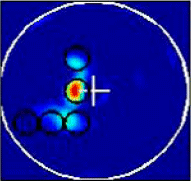 Selected related literature:
Selected related literature:
Bértolo, H., ``Visual imagery without visual perception?''
Psicológica, Vol. 26, pp. 173-188, 2005. Available
 online (PDF file).
online (PDF file).
Cui, X., Jeter, C.B., Yang, D., Montague, P.R. and Eagleman, D.M.,
``Vividness of mental imagery: individual variability can be measured objectively,''
Vision Research, Vol. 47, No. 4, pp. 474-478, February 2007. Available
 online (PDF file).
online (PDF file).
Merabet, L.B., Kobayashi, M., Barton, J. and Pascual-Leone, A.,
``Suppression of Complex Visual Hallucinatory Experiences by Occipital Transcranial
Magnetic Stimulation: A Case Report,'' Neurocase, Vol. 9, pp. 436-440, October 2003.
Merabet, L.B., Maguire, D., Warde, A., Alterescu, K., Stickgold, R. and Pascual-Leone, A.,
``Visual hallucinations during prolonged blindfolding in sighted subjects,''
Journal of Neuro-Ophthalmology, Vol. 24, pp. 109-113, June 2004. Available
 online (PDF file).
online (PDF file).
Noë, A., ``Is the visual world a grand illusion?'' Journal of Consciousness Studies, Vol. 9, No. 5/6, pp. 1-12, 2002. Available
 online (PDF file).
online (PDF file).
O'Callaghan, C., ``Seeing What You Hear: Cross-Modal Illusions and Perception,'' Philosophical Issues, 2008.
Pearson, J., Clifford, C.W.G. and Tong, F., ``The Functional Impact of Mental Imagery on Conscious Perception,''
Current Biology, Vol. 18, pp. 982-986, July 2008. Available
 online (PDF file).
online (PDF file).
Slotnick, S.D., ``Imagery: Mental Pictures Disrupt Perceptual Rivalry,''
Current Biology, Vol. 18, pp. R603-R605, July 2008. Available
 online (PDF file).
online (PDF file).
Sparing, R., Mottaghy, F. M., Ganis, G., Thompson, W. L., Töpper, R., Kosslyn, S. M. and Pascual-Leone, A.,
``Visual cortex excitability increases during visual mental imagery - a TMS study in healthy human subjects,''
in Brain Research, Vol. 938, pp. 92–97, 2002.
Thirion, B., Duchesnay, E., Hubbard, E., Dubois, J., Poline, J.B., Lebihan, D. and Dehaene, S.,
``Inverse retinotopy: Inferring the visual content of images from brain activation patterns,''
NeuroImage, Vol. 33, No. 4, pp. 1104-1116, 2006. Abstract available
 online.
online.
Literature and conference presentations on The vOICe approach:
Meijer, P.B.L., ``An Experimental System for Auditory Image Representations,''
IEEE Transactions on Biomedical Engineering, Vol. 39, No. 2,
pp. 112-121, Feb 1992. Reprinted in the 1993 IMIA Yearbook of Medical
Informatics, pp. 291-300.
Meijer, P. B. L. ``Cross-Modal Sensory Streams,'' Conference Abstracts
and Applications, ACM SIGGRAPH 98, p. 184, as part of an invited panel presentation and demonstration
of The vOICe for Windows at SIGGRAPH '98, Orlando, Florida, 1998.
Meijer, P. B. L. ``Seeing with Sound for the Blind: Is it Vision?,'' invited lecture
at the VSPA conference on Consciousness at the University of Amsterdam, Amsterdam, The Netherlands,
June 1, 2001.
Meijer, P. B. L., ``Seeing with Sound: Wearable Computing for the Blind,''
invited presentation at NIC2001 (Nordic Interactive Conference),
Copenhagen, Denmark, Thursday November 1, 2001.
Meijer, P. B. L., ``Seeing with Sound for the Blind: Is it Vision?,''
invited presentation at the Tucson 2002 conference on Consciousness in Tucson,
Arizona, USA, April 8, 2002.
Fletcher, P. D., ``Seeing with Sound: A Journey into Sight,''
invited presentation at the Tucson 2002 conference on Consciousness in Tucson,
Arizona, USA, April 8, 2002.
Stoerig, P., Ludowig, E., Meijer, P. B. L. and Pascual-Leone, A.,
``Seeing through the ears?,'' poster presentation at the
4th Forum of European Neuroscience (FENS Forum 2004) in Lisbon, Portugal, July 14, 2004.
Stoerig, P., Ludowig, E., Mierdorf, T., Oros-Peusquens, A., Shah, J. N., Meijer, P. B. and Pascual-Leone, A.,
``Seeing through the ears? Identification of images converted to sounds improves with practice,''
poster presentation at the 34th Annual Meeting of the Society for Neuroscience (SfN 2004) in San Diego, USA,
Sunday October 24, 2004.
Amedi, A., Bermpohl, F. , Camprodon, J., Fox, S., Merabet, L., Meijer, P. and Pascual-Leone, A.,
``Neural correlates of visual-to-auditory sensory substitution in proficient blind users,''
poster presentation at the 12th Annual Meeting of the Cognitive Neuroscience Society (CNS 2005) in New York, USA,
April 11, 2005, and at the 57th Annual Meeting of the
American Academy of Neurology (AAN 2005), Miami Beach, Florida, USA, April 10 and 12, 2005.
For other useful literature, see recent publications on mental imagery.
Note: Psychologists might wish to consider the proposed immersive usage of The vOICe
during training in the context of James Gibson's ecological theory of perception
(Gibson, J.J., 1979, "The ecological approach to visual perception," Boston: Houghton Mifflin).
A good entry point to mental imagery and its history in science, including many references,
is the website of
 Nigel Thomas
of California State University on Mental Imagery, Consciousness, and Cognition.
Other good resources for related (philosophical, psychological) topics are the websites of
Nigel Thomas
of California State University on Mental Imagery, Consciousness, and Cognition.
Other good resources for related (philosophical, psychological) topics are the websites of
 David Chalmers of the Australian National University,
David Chalmers of the Australian National University,
 Alva Noë of the University of California, Santa Cruz,
Alva Noë of the University of California, Santa Cruz,
 Zenon Pylyshyn of Rutgers University,
Zenon Pylyshyn of Rutgers University,
 Stephen Kosslyn of Harvard University, and
Stephen Kosslyn of Harvard University, and
 Daniel Dennett of Tufts University.
For more information on The vOICe technology, visit
The vOICe Home Page.
Daniel Dennett of Tufts University.
For more information on The vOICe technology, visit
The vOICe Home Page.
In addition, VRML/X3D versions of 3D mental rotation test objects are available on the
Shepard-Metzler page.
The combination of smart camera and other sensor technologies with
general synthetic vision mappings and automatic scene analysis should eventually
offer blind people improved mobility, independence, situation awareness and safety.
Copyright © 1996 - 2024 Peter B.L. Meijer



